East 11th Street in New York City’s vibrant East Village holds layers of history, architecture, and cultural significance. While recent developments have threatened some of its historical fabric, the street remains a fascinating testament to New York’s evolving urban landscape. Among its notable landmarks, Webster Hall at 125 East 11th Street stands out as a beacon of entertainment and community life for over a century.
Recently, concerns arose when the Greenwich Village Society for Historic Preservation (GVSHP) advocated for landmark status for a section of East 11th Street between Third and Fourth Avenues. This proposal aimed to protect a collection of buildings, including 112-120 East 11th Street, 113 East 11th Street (the former St. Ann’s Parochial School), 125 East 11th Street (Webster Hall), 122 East 11th Street/64 Third Avenue, and 93 Fourth Avenue (Cooper Station Post Office). These structures collectively narrate the story of working-class and immigrant New York in the late 19th and early 20th centuries.
Despite the GVSHP’s urgent appeal, the Landmarks Preservation Commission (LPC) did not respond, and demolition permits were approved for 112-120 East 11th Street. This loss of 19th-century tenements, largely in the Beaux Arts style, is a blow to the historical integrity of the East Village.
To understand the significance of this area, we must delve into its past. In the early 19th century, row houses dominated this part of the East Village. A surviving example of this era is 122 East 11th Street/64 Third Avenue, originally constructed as two Greek Revival row houses in the 1830s. By 1853, maps described them as dwellings with stores below, reflecting the area’s growing commercial and residential mix. Later in the 19th century, these buildings were adapted into tenements to house the influx of immigrant and working-class families.
Historical Beaux Arts tenements at 116-120 East 11th Street, now facing demolition, highlighting architectural heritage in the East Village.
The expansion of New York City’s Catholic community in the 19th century also left its mark on East 11th Street. St. Ann’s Parochial School, formerly located at 113 East 11th Street, exemplifies this growth. In 1870, St. Ann’s Parish acquired land behind its East 12th Street church to build a new school. Designed by Napoleon Le Brun, renowned for his New York City firehouse designs, the school opened in 1870, accommodating 560 students. Though converted to apartments in 1978, the building retains its original facade, including a stone disc inscribed with “St. Ann’s Parochial School, 1870” and separate entrances for boys and girls.
An 1853 Perris map showing the intersection of Third Avenue and East 11th Street in New York, illustrating the historical layout of the area.
Webster Hall, the jewel in the crown of East 11th Street’s entertainment history, was erected in 1886-87 for Charles Goldstein. Architect Charles Rentz, Jr. designed the original Queen Anne style structure, with an eastern annex added in 1892 in the Renaissance Revival style. From its inception, Webster Hall became a vital community hub, hosting a diverse array of events, from balls and dances to lectures and political rallies. It served as a significant social center, particularly for the working-class and immigrant communities of the Lower East Side. Recognizing its cultural and historical importance, New York City designated Webster Hall as a landmark in 2007. This designation cemented its place as a protected historical and cultural site within the city.
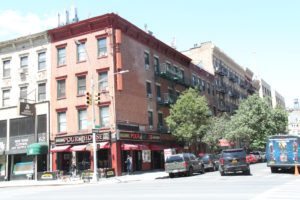 122 East 11th Street/64 Third Avenue
122 East 11th Street/64 Third Avenue
The building at 122 East 11th Street/64 Third Avenue, showcasing the architectural evolution from early row houses to later tenement modifications.
The same year Webster Hall was built, construction began on the first of five “old law” tenements at 112 East 11th Street. These tenements, replacing earlier row houses, were designed by architects like William Graul, Julius Kastner, and Oswald Wirz. These buildings, including 112, 114, 116, 118, and 120 East 11th Street, exemplified the Beaux Arts style and housed a diverse population of first and second-generation immigrants, primarily from Germany, Italy, Russia, Spain, and Ireland. Census records from the early 20th century paint a vivid picture of the diverse communities living in these buildings.
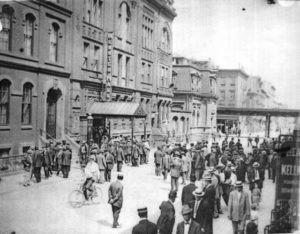 Webster Hall in 1913, photo International News Service
Webster Hall in 1913, photo International News Service
Webster Hall in 1913, captured by International News Service, illustrating its long-standing presence as a cultural hub on East 11th Street.
Completing the historical tapestry of this section of East 11th Street is the Cooper Station Post Office at 93 Fourth Avenue. Constructed between 1936 and 1937 as part of a public works program, it was one of twelve post offices built in New York City during the 1930s. Designed by William Dewey Foster in the Classical Revival style, the Cooper Station’s curved facade at the corner of Fourth Avenue and East 11th Street is a striking architectural feature. Its two-story colonnade with Doric columns further accentuates its design. The Cooper Station Post Office earned its place on the New York State and National Registers of Historic Places in 1982.
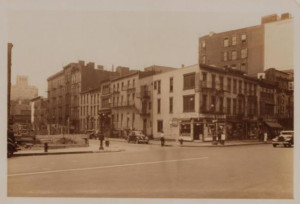 East 11th Street looking southeast from Fourth Avenue, June 27, 1936, NYPL
East 11th Street looking southeast from Fourth Avenue, June 27, 1936, NYPL
East 11th Street in 1936, looking southeast from Fourth Avenue, showcasing the urban landscape including the future site of Cooper Station Post Office.
The East Village remains largely under-landmarked, making the demolition of 112-120 East 11th Street a poignant example of the vulnerability of its historic resources. Webster Hall, however, stands as a preserved testament to the rich history of East 11th Street and the ongoing efforts to protect the unique character of the East Village. Exploring Webster Hall and the surrounding architecture offers a glimpse into New York City’s dynamic past and the importance of preserving its historical landmarks.
Tenements at 112 and 114 East 11th Street, representing the architectural style and historical residential buildings impacted by recent demolitions.
 Cooper Station Post Office site prior to construction, NYPL
Cooper Station Post Office site prior to construction, NYPL
The site of Cooper Station Post Office before construction, providing a historical perspective on the urban development at the corner of Fourth Avenue and East 11th Street.
Cooper Station Post Office on East 11th Street, a Classical Revival architectural landmark serving the East Village community.

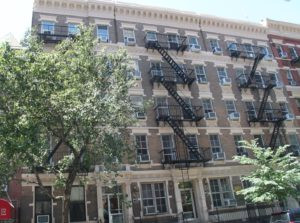
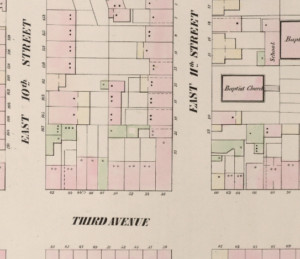 1853 Perris Map, NYPL
1853 Perris Map, NYPL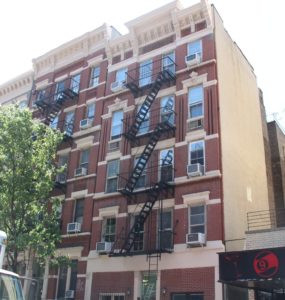 112 and 114 East 11th Street
112 and 114 East 11th Street Cooper Station Post Office
Cooper Station Post Office